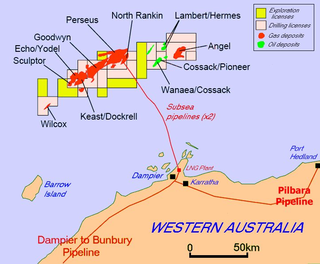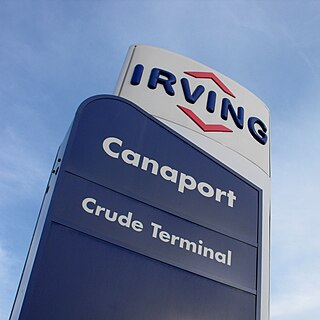Related Research Articles

Sabine Pass is the natural outlet of Sabine Lake into the Gulf of Mexico. It borders Jefferson County, Texas, and Cameron Parish, Louisiana.

Liquefied natural gas (LNG) is natural gas (predominantly methane, CH4, with some mixture of ethane, C2H6) that has been cooled down to liquid form for ease and safety of non-pressurized storage or transport. It takes up about 1/600th the volume of natural gas in the gaseous state (at standard conditions for temperature and pressure).

A floating production storage and offloading (FPSO) unit is a floating vessel used by the offshore oil and gas industry for the production and processing of hydrocarbons, and for the storage of oil. An FPSO vessel is designed to receive hydrocarbons produced by itself or from nearby platforms or subsea template, process them, and store oil until it can be offloaded onto a tanker or, less frequently, transported through a pipeline. FPSOs are preferred in frontier offshore regions as they are easy to install, and do not require a local pipeline infrastructure to export oil. FPSOs can be a conversion of an oil tanker or can be a vessel built specially for the application. A vessel used only to store oil is referred to as a floating storage and offloading (FSO) vessel.

Petronet LNG Ltd is an Indian oil and gas company formed by the government of India to import liquefied natural gas (LNG) and set up LNG terminals in the country. It is a joint venture company promoted by the Gas Authority of India Limited (GAIL), Oil and Natural Gas Corporation Limited (ONGC), Indian Oil Corporation Limited (IOC) and Bharat Petroleum Corporation Limited (BPCL). Petronet LNG Limited, one of the companies in the Indian energy sector, has set up the country's first LNG receiving and regasification terminal in Dahej, Gujarat, and another terminal in Kochi, Kerala. While the Dahej terminal has a nominal capacity of 17.5 million tonnes per year, the Kochi terminal has a capacity of 5 million tonnes per year. Plans to build a third LNG terminal in Gangavaram, Andhra Pradesh were dropped in October 2019.

Cove Point LNG Terminal is an offshore liquid natural gas shipping terminal operated by BHE GT&S, a Berkshire Hathaway Energy company. It is located near Lusby, Maryland, United States, on the western shore of the Chesapeake Bay, and exports liquefied natural gas (LNG) and also stores gas. LNG is exported on specially designed ships known as LNG carriers.
LNG Hrvatska d.o.o. is a company that operates a floating liquefied natural gas (LNG) regasification terminal in Omišalj on the island of Krk, Croatia. It commenced operations on 1 January 2021, with full capacity booked for the next three years.

The North West Shelf Venture, situated in the north-west of Western Australia, is Australia's largest resource development project. It involves the extraction of petroleum at offshore production platforms, onshore processing and export of liquefied natural gas, and production of natural gas for industrial, commercial and domestic use within the state.

The Adriatic LNG terminal is a liquid natural gas offshore terminal, formally known as Terminale GNL Adriatico Srl. Located in the northern Adriatic 9 miles (14 km) offshore of Porto Levante, Porto Viro, near Rovigo, Italy, it is the world's first offshore gravity-based structure LNG regasification terminal. The terminal is operated by ExxonMobil (70%), Qatar Terminal Ltd., a subsidiary of Qatar Petroleum (23%), and Snam (7%).
Yamal project, also referred to as Yamal megaproject, is a long-term plan to exploit and bring to the markets the vast natural gas reserves in the Yamal Peninsula, Russia. Administratively, the project is located in the Yamalo-Nenets Autonomous Okrug. The project is developed by Gazprom.

Nakilat is a Qatari shipping and maritime company. Its LNG shipping fleet is the largest in the world, comprising 69 vessels. The company also jointly owns one Floating Storage Regasification Unit (FSRU) and 4 very large LPG carriers (VLGCs). Through its in-house shipmanagement, Nakilat manages and operates the four very large LPG carriers and 14 LNG carriers.

Canaport is a Canadian marine crude oil receiving terminal located on the north shore of the Bay of Fundy at Mispec Point, approximately 9 km (5.6 mi) southeast of the city of Saint John, New Brunswick.

A liquefied natural gas terminal is a facility for managing the import and/or export of liquefied natural gas (LNG). It comprises equipment for loading and unloading of LNG cargo to/from ocean-going tankers, for transfer across the site, liquefication, re-gasification, processing, storage, pumping, compression, and metering of LNG. LNG as a liquid is the most efficient way to transport natural gas over long distances, usually by sea.

Klaipėda liquefied natural gas floating storage and regasification unit terminal or Klaipėda LNG FSRU is an LNG terminal in the port of Klaipėda, Lithuania. It cost US$128 million to construct. The project operator is Klaipedos Nafta.
Bangladesh is the sixteenth-largest producer of natural gas in Asia. Gas supplies meet 56% of domestic energy demand. However, the country faces an acute energy crisis in meeting the demands of its vast and growing population. Bangladesh is a net importer of crude oil and petroleum products. The energy sector is dominated by state-owned companies, including Petrobangla and the Bangladesh Petroleum Corporation. Chevron, ConocoPhillips, Equinor, Gazprom and ONGC are major international companies engaged in Bangladesh's hydrocarbon industry, with Chevron's gas fields accounting for 50% of natural gas production.

Costa Azul LNG is sea port and natural gas processing center, located 15 miles north of Ensenada, Baja California, Mexico. Opened in 2008, the terminal can process, regasification, up to one billion cubic feet of natural gas per day. This is the first liquefied natural gas (LNG) terminal on the North America west coast. LNG carrier ships capable of holding up to 220,000m3 of LNG can dock in the deep water port off the coast to unload LNG. The natural gas from the terminal is used to produce electricity and is fed by pipe lines to factories. The longest pipeline runs north, to the United States. Sempra Energy is a partner in the port with PEMEX. The LNG ship Al Safliya was the first ship to port and unload at Costa Azul. The Al Safliya is a 210,000 cubic meter LNG ship, its LNG was from Qatar. The other Mexican LNG Terminal in the Pacific Ocean is at Manzanillo, Colima, the Manzanillo LNG Terminal.
Grain LNG Terminal is a Liquefied Natural Gas (LNG) terminal on the Isle of Grain, 37 miles (60 km) east of London. It has facilities for the offloading and reloading of LNG from ships at two jetties on the River Medway; for storing and blending LNG; for truck loading; and regasifying and blending natural gas to meet UK specifications. The terminal can handle up to 15 million tonnes per annum of LNG, has storage capacity for one million cubic metres of LNG, and is able to regasify up to 645 GWh per day for delivery into the high pressure gas National Transmission System (NTS). The facility is owned and operated by National Grid Grain LNG Ltd, a wholly owned subsidiary of National Grid.
MT MOL FSRU Challenger is a Bahamas-flagged liquefied natural gas (LNG) carrier, which is currently laid up in Singapore.
nogaholding is a semi-independent agency within the Ministry of Oil and Gas in the nation of Bahrain whose mission is to develop the nation's petroleum resources. Established in 2007 as a unit of the National Oil and Gas Authority (NOGA), the government's petroleum regulator, it became an independent agency when NOGA was abolished in September 2021.
References
- ↑ "StackPath".
- ↑ "StackPath".
- ↑ "Energy-pedia – upstream oil & gas news for EP professionals".
- ↑ "Submerged Turret Loading".
- ↑ "Excelerate Buys Rights to el Paso's Energy Bridge LNG Technology; Takes over Project". 18 December 2003.
- ↑ "Excelerate Energy | Leader in Integrated LNG Solutions".
- ↑ "First Deepwater LNG Import Facility to be Retired". 20 April 2011.
- ↑ "Federal Register :: Request Access".
- ↑ "MARAD OKs Retirement of First LNG Deepwater Facility". 15 August 2013.
- ↑ "A Barrel Full", oil industry website.